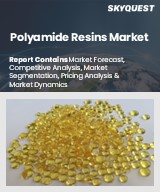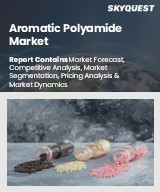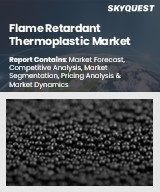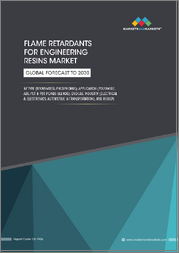
|
시장보고서
상품코드
1809655
카보하이드라지드 시장 : 형태, 등급, 용도, 최종 이용 산업, 유통 채널별 - 세계 예측(2025-2030년)Carbohydrazide Market by Form, Grade, Application, End Use Industry, Distribution Channel - Global Forecast 2025-2030 |
||||||
카보하이드라지드 시장은 2024년에는 9억 5,010만 달러로 평가되었으며, 2025년에는 10억 311만 달러, CAGR 5.71%로 성장하여 2030년에는 13억 2,601만 달러에 달할 것으로 예측됩니다.
| 주요 시장 통계 | |
|---|---|
| 기준 연도 2024년 | 9억 5,010만 달러 |
| 추정 연도 2025년 | 10억 311만 달러 |
| 예측 연도 2030년 | 13억 2,601만 달러 |
| CAGR(%) | 5.71% |
진화하는 산업 응용 및 규제 압력 속에서 카보하이드라지드 산업의 기본 역학과 전략적 중요성을 탐구합니다.
카보하이드라지드의 산업 환경은 산업 공정 및 환경 보호 응용 분야에서 매우 중요한 역할에 의해 정의됩니다. 다용도의 백색 결정성 화합물로서 보일러 수처리에서 탈산제, 고분자 제조에서 안정제, 특수 화학 합성에서 주요 중간체 역할을 합니다. 화학 처리에서 사진 현상까지 다양한 용도로 사용되며, 성능과 지속가능성을 모두 추구하는 산업에서 전략적으로 중요한 역할을 하고 있습니다.
카보하이드라지드의 생산, 용도, 공급망 역학에 영향을 미치는 산업 전반에 걸쳐 매우 중요한 기술 및 규제 변화의 평가
카보하이드라지드 시장은 기술 발전, 지속가능성 요구, 규제 프레임워크의 변화로 인해 격렬한 변화의 시기를 맞이하고 있습니다. 최신 생산 방식에서 녹색 화학의 원칙이 점점 더 강조되고 있으며, 제조업체는 에너지 소비를 최소화하고 위험한 중간체에 대한 의존도를 줄이기 위해 합성 경로를 최적화하고 있습니다. 동시에 공급망 전반의 디지털화 노력은 품질 매개변수를 실시간으로 모니터링하고, 추적성을 강화하며, 전체 프로세스의 효율성을 향상시키고 있습니다.
2025년 미국의 관세 조치가 카보하이드라지드 시장의 비용 구조, 무역 패턴, 공급망 탄력성을 어떻게 변화시켰는지 분석합니다.
2025년 미국은 일부 화학제품 수입에 관세를 부과하여 카보하이드라지드와 그 전구체에 영향을 미치는 비용 구조와 무역 흐름에 중대한 변화를 가져왔습니다. 수입 관세는 전 세계 공급업체들의 육지 비용을 상승시켰고, 외부 가격 압력에 대한 노출을 줄이기 위해 국내 생산 확대와 공급업체 다변화를 촉진했습니다. 많은 소비자들은 공급업체와의 계약을 재평가하고, 보다 예측 가능한 공급 체계를 확보하기 위해 니어쇼어 파트너십을 체결하는 방식으로 대응하고 있습니다.
제형, 등급, 용도, 최종 사용 산업, 유통 채널에 대한 중요한 인사이트를 제공하여 카보하이드라지드에 대한 전략적 의사결정에 도움을 줍니다.
제형 기반 세분화를 자세히 분석하면, 카보히드라지드의 액상 제제는 수성 및 용매 기반 제제를 모두 포함하며, 최종사용자가 쉽게 투여할 수 있고 치료 시스템에 빠르게 용해되는 것으로 나타났습니다. 반대로, 펠릿, 과립, 분말 형태로 제공되는 고체 제제는 원거리 운송이나 드라이 블렌딩에 통합해야 하는 응용 분야에서 저장 안정성 및 취급에 있어 물류상의 이점을 제공합니다.
변화하는 수요 패턴 속에서 아메리카, 유럽, 중동 및 아프리카, 아시아태평양의 카보하이드라지드 시장의 지역 동향과 전략적 기회를 파악합니다.
지역별 분석에 따르면, 아메리카는 특히 발전 및 지자체 수처리 분야에서 인프라가 잘 구축되어 있는 성숙한 시장으로 나타났습니다. 북미의 규제 프레임워크는 엄격한 폐수 기준을 요구하고 있으며, 탈산제 및 부식 방지제에 대한 안정적인 수요를 견인하고 있습니다.
세계 카보하이드라지드 생태계를 형성하는 주요 산업 플레이어의 전략적 포지셔닝, 혁신 노력, 경쟁적 접근 방식에 주목
업계 주요 참여 기업들은 통합된 가치사슬, 전략적 파트너십, 타겟팅된 제품 혁신을 통해 차별화를 꾀하고 있습니다. 오랜 전통의 특수화학 제조업체는 규모와 전통적 관계를 활용하여 보일러 처리 및 부식 용도의 산업용 카보하이드라지드를 대량으로 공급하고 있습니다. 중견 제조업체는 기술 등급 제품에 중점을 두고 열 안정화 및 고분자 첨가제 배합에 대한 틈새 역량을 개발하고 있습니다.
경쟁 우위를 강화하고, 지속가능한 관행을 촉진하고, 카보하이드라지드의 새로운 기회를 활용하기 위한 이해관계자의 전략적 행동을 수립합니다.
업계 리더들은 진화하는 환경 규제를 충족시키면서 비용 효율성을 달성하기 위해 친환경 합성 및 공정 강화에 대한 투자를 우선시해야 합니다. 고성장 중인 아시아태평양 시장에서의 생산능력 확대로 빠르게 성장하는 수요처에 대한 접근성을 확보할 수 있습니다. 한편, 북미와 유럽에서의 현지 생산은 관세 제도의 변화 속에서 공급의 안정성을 높입니다.
카보하이드라지드 조사에서 데이터의 엄격성, 분석의 정확성, 편견 없는 조사 결과를 보장하기 위해 채택한 종합적인 조사 방법 개요
이 조사 방법은 데이터의 완전성과 편견 없는 인사이트를 보장하기 위해 1차 조사와 2차 조사를 엄격하게 결합하는 방식입니다. 주요 산업 분야의 업계 임원, 기술 전문가, 최종사용자 조달 담당자와의 구조화된 인터뷰를 통해 1차 자료를 수집했습니다. 이러한 인사이트는 생산 공정과 품질 기준을 검증하기 위한 공장 방문과 현장 관찰을 통해 보완되었습니다.
카보하이드라지드 분야의 지속적인 진화에서 정보에 입각한 의사결정을 지원하기 위한 핵심 인사이트와 전략적 함의에 대한 요약.
카보하이드라지드 분야는 규제 진화, 기술 혁신, 무역 패러다임 변화의 교차점에 위치하고 있습니다. 수처리 및 부식 방지에서 카보하이드라지드의 역할은 고분자 및 전문가 합성에 대한 새로운 응용이 가속화되고 있지만 여전히 기초적인 역할을 하고 있습니다. 관세로 인한 무역 재편은 공급망 민첩성과 지역 제조 능력의 중요성을 강조하고 있습니다.
목차
제1장 서문
제2장 조사 방법
제3장 주요 요약
제4장 시장 개요
제5장 시장 역학
제6장 시장 인사이트
- Porter's Five Forces 분석
- PESTEL 분석
제7장 미국 관세의 누적 영향 2025
제8장 카보하이드라지드 시장 : 형태별
- 액체
- 수용액
- 용제형 솔루션
- 고체
- 펠릿/과립
- 분말
제9장 카보하이드라지드 시장 : 등급별
- 산업용 등급
- 의약품 등급
- 테크니컬 등급
제10장 카보하이드라지드 시장 : 용도별
- 화학 중간체
- 열 안정제
- 산소 제거
- 사진 사용
제11장 카보하이드라지드 시장 : 최종 이용 산업별
- 농업
- 화학 제조
- 석유 및 가스
- 의약품 제조
- 발전
- 수처리 산업
제12장 카보하이드라지드 시장 : 유통 채널별
- 오프라인 판매
- 직접 판매
- 판매대리점
- 온라인 판매
제13장 아메리카의 카보하이드라지드 시장
- 미국
- 캐나다
- 멕시코
- 브라질
- 아르헨티나
제14장 유럽, 중동 및 아프리카의 카보하이드라지드 시장
- 영국
- 독일
- 프랑스
- 러시아
- 이탈리아
- 스페인
- 아랍에미리트
- 사우디아라비아
- 남아프리카공화국
- 덴마크
- 네덜란드
- 카타르
- 핀란드
- 스웨덴
- 나이지리아
- 이집트
- 튀르키예
- 이스라엘
- 노르웨이
- 폴란드
- 스위스
제15장 아시아태평양의 카보하이드라지드 시장
- 중국
- 인도
- 일본
- 호주
- 한국
- 인도네시아
- 태국
- 필리핀
- 말레이시아
- 싱가포르
- 베트남
- 대만
제16장 경쟁 구도
- 시장 점유율 분석, 2024년
- FPNV 포지셔닝 매트릭스, 2024년
- 경쟁 분석
- Acuro Organics Limited
- Ataman Kimya A.S.
- Avanschem
- Avantor, Inc.
- Fengchen Group Co.,Ltd.
- Hefei TNJ Chemical Industry Co.,Ltd.
- Hefei Home Sunshine Pharmaceutical Technology Co., Ltd.
- Merck KGaA
- Otto Chemie Pvt. Ltd.
- Jinan Qinmu Fine Chemical Co.,Ltd.
- RXCHEMICALS
- Sarna Chemical
- Shandong Kairui Chemistry Co., Ltd.
- Shanghai Lonwin Chemical Co., Ltd.
- Spectrum Chemical Mfg. Corp.
- Starsky international holdings Co., Ltd.
- Thermo Fisher Scientific Inc.
- Tokyo Chemical Industry Co., Ltd.
- Vizag Chemical International
- Yingfengyuan Industrial Group Limited
- Chemtex Speciality Limited
제17장 리서치 AI
제18장 리서치 통계
제19장 리서치 컨택트
제20장 리서치 기사
제21장 부록
KSM 25.09.23The Carbohydrazide Market was valued at USD 950.10 million in 2024 and is projected to grow to USD 1,003.11 million in 2025, with a CAGR of 5.71%, reaching USD 1,326.01 million by 2030.
| KEY MARKET STATISTICS | |
|---|---|
| Base Year [2024] | USD 950.10 million |
| Estimated Year [2025] | USD 1,003.11 million |
| Forecast Year [2030] | USD 1,326.01 million |
| CAGR (%) | 5.71% |
Exploring the Fundamental Dynamics and Strategic Imperatives of the Carbohydrazide Industry Amid Evolving Industrial Applications and Regulatory Pressures
The carbohydrazide landscape is defined by its pivotal role in industrial processes and environmental safeguarding applications. As a versatile white crystalline compound, it serves as an oxygen scavenger in boiler water treatment, a stabilizer in polymer manufacturing, and a key intermediate in specialty chemical synthesis. Its multifaceted utility spans from chemical processing to photographic development, underscoring its strategic importance for industries seeking both performance and sustainability.
Recent years have witnessed heightened regulatory scrutiny around water treatment and emissions controls, elevating the demand for reliable oxygen-scavenging agents that meet increasingly stringent environmental guidelines. Simultaneously, end users in power generation and oil & gas sectors are pursuing cost-effective alternatives to traditional inhibitors, positioning carbohydrazide as a compelling solution. As technological innovation accelerates and global supply chains adapt to geopolitical shifts, understanding the underlying drivers of this market has never been more critical.
This executive summary provides a concise yet comprehensive overview of the forces shaping the carbohydrazide sector, equipping decision-makers with the insights needed to navigate evolving challenges, optimize operations, and capitalize on emerging growth pathways.
Assessing the Pivotal Technological and Regulatory Transformations Reshaping Carbohydrazide Production, Application, and Supply Chain Dynamics Across Industries
The carbohydrazide market is undergoing a period of intense transformation driven by technological advancements, sustainability imperatives and shifting regulatory frameworks. Modern production methods are increasingly emphasizing green chemistry principles, with manufacturers optimizing synthetic pathways to minimize energy consumption and reduce reliance on hazardous intermediates. Concurrently, digitalization initiatives across the supply chain are enabling real-time monitoring of quality parameters, enhancing traceability and improving overall process efficiency.
Regulatory bodies in key markets have introduced stricter controls over water effluent and air emissions, prompting end users to adopt more effective corrosion inhibitors and oxygen scavengers. This has accelerated R&D efforts to develop high-purity grades and tailor performance characteristics to specific industrial applications. At the same time, growing awareness of environmental stewardship is driving industry players to pursue circular economy strategies, such as recycling process streams and reclaiming spent reagents.
These converging trends are reshaping competitive dynamics and unlocking new value propositions. Stakeholders who proactively integrate innovative technologies, adhere to evolving compliance requirements and anticipate end-user needs are poised to capture significant advantages in an increasingly complex marketplace.
Analyzing How 2025 Tariff Measures in the United States Have Altered Cost Structures, Trade Patterns, and Supply Chain Resilience in Carbohydrazide Markets
In 2025, the imposition of tariffs on select chemical imports by the United States introduced material shifts in cost structures and trade flows affecting carbohydrazide and its precursors. Import duties have elevated landed costs for global suppliers, incentivizing domestic production scale-up and supplier diversification to mitigate exposure to external pricing pressures. Many consumers have responded by reevaluating vendor contracts and forging near-shore partnerships to secure more predictable supply arrangements.
These tariff measures have also stimulated investments in process optimization and alternative raw material sourcing. Companies that had previously relied on low-cost imports have accelerated initiatives to localize production and leverage regional feedstock advantages. While short-term price volatility presented challenges, the resulting shift toward strengthened domestic capabilities is anticipated to enhance long-term supply chain resilience.
Trade pattern adjustments have been especially notable in sectors such as power generation and industrial water treatment, where consistent access to high-purity oxygen scavengers is mission-critical. As stakeholders adapt to this new trade environment, collaborative procurement strategies and long-term offtake agreements are emerging as effective mechanisms to manage tariff-driven uncertainties and ensure operational continuity.
Unveiling Critical Insights across Formulation, Grade, Application, End Use Industries and Distribution Channels to Drive Strategic Carbohydrazide Decisions
Detailed analysis of form-based segmentation reveals that liquid carbohydrazide formulations, encompassing both aqueous and solvent-based variants, offer end users enhanced ease of dosing and faster solubility in treatment systems. Conversely, the solid forms, available as pellets, granules or powders, deliver logistical advantages in storage stability and handling for applications requiring transport to remote sites or integration into dry blends.
From a grade perspective, industrial-grade materials cater to large-scale boiler water and corrosion control systems, whereas pharmaceutical-grade carbohydrazide meets the rigorous purity standards of active pharmaceutical ingredient synthesis. Technical-grade variants strike a balance between cost efficiency and functional performance, making them suited for chemical intermediate applications and heat-stabilizer roles in polymer processing.
Application segmentation highlights that carbohydrazide's role as an oxygen scavenger remains its largest demand driver, particularly in boiler water treatment and steam cycle protection. Its utility as a chemical intermediate underpins specialty syntheses, while niche photographic uses persist in select imaging processes. The end-use industry breakdown underscores robust activity in agriculture, chemical manufacturing, oil & gas, pharmaceutical manufacturing, power generation and water treatment, each presenting distinct performance requirements and procurement dynamics.
Distribution channels further shape market engagement models. Traditional offline channels, comprising direct sales and third-party distributors, continue to dominate bulk procurement for industrial clients. Growth in online sales, however, is reshaping smaller-order purchasing behaviors, enabling rapid fulfillment and transparency in product specifications.
Delineating Regional Trends and Strategic Opportunities across the Americas, EMEA and Asia-Pacific Carbohydrazide Markets Amid Changing Demand Patterns
Regional analysis indicates that the Americas region exhibits a mature market characterized by established infrastructure, particularly in power generation and municipal water treatment. Regulatory frameworks in North America mandate stringent water effluent standards, driving steady demand for oxygen-scavenging solutions and corrosion inhibitors.
Across Europe, the Middle East and Africa, environmental directives and decarbonization initiatives are catalyzing the adoption of advanced treatment chemistries. European industrial hubs are increasingly investing in high-purity carbohydrazide to meet aggressive emission reduction targets, while Middle Eastern petrochemical facilities prioritize reliable corrosion control in harsh operating conditions.
Asia-Pacific stands out for its rapid growth trajectory, fueled by expanding energy portfolios, burgeoning chemical manufacturing capacity and rising infrastructure spending. Nations such as China and India are ramping up boiler operations and power plants, generating significant opportunities for carbohydrazide suppliers. Moreover, regional government programs promoting clean energy and water reuse are expected to further bolster demand for specialized treatment agents.
Highlighting Leading Industry Players' Strategic Positioning, Innovation Initiatives and Competitive Approaches Shaping the Carbohydrazide Ecosystem Worldwide
Key industry participants are distinguishing themselves through integrated value chains, strategic partnerships and targeted product innovation. Established specialty chemical firms leverage scale and legacy relationships to supply high-volume industrial-grade carbohydrazide for boiler treatment and corrosion applications. Mid-tier manufacturers focus on technical-grade offerings, developing niche capabilities around heat stabilization and polymer additive formulations.
Pharmaceutical-grade producers have intensified quality control protocols to align with Good Manufacturing Practice requirements, enabling penetration into sensitive API synthesis segments. Emerging players are exploring bio-based synthesis routes and continuous flow technologies to reduce environmental footprint and production costs, signaling a shift toward more sustainable manufacturing models.
Competitive dynamics are further influenced by alliances between upstream raw material providers and downstream service integrators, facilitating bundled solutions that combine chemical supply with monitoring and maintenance services. Such collaborative approaches are gaining traction among end users seeking to streamline vendor management and improve overall water treatment efficacy.
Formulating Strategic Actions for Stakeholders to Enhance Competitive Advantage, Drive Sustainable Practices and Capitalize on Emerging Carbohydrazide Opportunities
Industry leaders should prioritize investments in green synthesis and process intensification to achieve cost efficiency while meeting evolving environmental regulations. Expanding production capacity in high-growth Asia-Pacific markets can unlock access to rapidly emerging demand centers, whereas localized manufacturing in North America and Europe enhances supply security under shifting tariff regimes.
Collaborative partnerships with technology providers and research institutions can accelerate the development of next-generation carbohydrazide derivatives tailored for specialized applications such as advanced polymers and high-temperature systems. Embracing digital tools for real-time quality monitoring and predictive maintenance will further strengthen operational resilience and reduce downtime.
To capture incremental value, stakeholders should also explore integrated service models that combine chemical supply with remote monitoring, analytics and performance guarantees. Finally, maintaining proactive regulatory engagement and scenario planning will enable companies to anticipate policy revisions and adapt swiftly, ensuring sustained market leadership.
Outlining Comprehensive Research Methodology Employed to Ensure Data Rigor, Analytical Accuracy and Unbiased Insights in Carbohydrazide Study
The study's methodology encompasses a rigorous blend of primary and secondary research to ensure data integrity and unbiased insights. Primary inputs were collected through structured interviews with industry executives, technical experts and end-user procurement officers across key verticals. These insights were supplemented by plant visits and on-site observations to validate production processes and quality standards.
Secondary research involved a thorough review of peer-reviewed journals, patent databases, regulatory filings and corporate disclosures. Proprietary data sources and white papers were analyzed to map product pipelines, technology roadmaps and strategic collaborations. All collected information underwent cross-verification through triangulation, comparing multiple sources to confirm accuracy and completeness.
Quantitative analyses utilized statistical techniques to assess segmentation impacts and regional dynamics, while qualitative frameworks were applied to evaluate competitive positioning and innovation trajectories. The combined approach delivers a holistic perspective, equipping stakeholders with both granular detail and high-level strategic context.
Summarizing Core Insights and Strategic Implications to Support Informed Decision-Making in the Carbohydrazide Sector's Continued Evolution
The carbohydrazide sector is poised at the intersection of regulatory evolution, technological innovation and shifting trade paradigms. Its established role in water treatment and corrosion control remains foundational, even as emerging applications in polymers and specialist syntheses gain momentum. Tariff-induced trade realignments have underscored the importance of supply chain agility and regional manufacturing capabilities.
Segmentation analysis highlights diverse value propositions across form, grade, application and distribution channels, reinforcing the need for tailored go-to-market strategies. Regional trends reveal distinct growth drivers in the Americas, EMEA and Asia-Pacific, each shaped by local regulatory environments and end-user demands. Leading companies are responding with integrated solutions, sustainable production methods and targeted innovation to maintain competitive edge.
By implementing the actionable recommendations outlined herein, industry participants can navigate current challenges and seize opportunities presented by evolving market conditions. With robust research methodology underpinning these findings, decision-makers can move forward with confidence, armed with the strategic insights required to drive growth and resilience.
Table of Contents
1. Preface
- 1.1. Objectives of the Study
- 1.2. Market Segmentation & Coverage
- 1.3. Years Considered for the Study
- 1.4. Currency & Pricing
- 1.5. Language
- 1.6. Stakeholders
2. Research Methodology
- 2.1. Define: Research Objective
- 2.2. Determine: Research Design
- 2.3. Prepare: Research Instrument
- 2.4. Collect: Data Source
- 2.5. Analyze: Data Interpretation
- 2.6. Formulate: Data Verification
- 2.7. Publish: Research Report
- 2.8. Repeat: Report Update
3. Executive Summary
4. Market Overview
- 4.1. Introduction
- 4.2. Market Sizing & Forecasting
5. Market Dynamics
- 5.1. Rising demand for ecofriendly carbohydrazide substitutes in boiler treatment chemicals across Asia markets
- 5.2. Emerging regulatory pressures drive innovation in low impurity carbohydrazide production for power utilities
- 5.3. Strategic partnerships accelerate development of bio based carbohydrazide for sustainable water treatment processes
- 5.4. Expansion of high purity carbohydrazide manufacturing capacity in China to meet global specialty chemical demand
- 5.5. Technological breakthroughs in continuous flow synthesis improve safety and efficiency of carbohydrazide production
- 5.6. Shift towards greener oxygen scavengers enhances adoption of carbohydrazide alternatives in thermal power plants
- 5.7. Integration of digital monitoring systems optimizes carbohydrazide dosing in boiler water management applications
6. Market Insights
- 6.1. Porter's Five Forces Analysis
- 6.2. PESTLE Analysis
7. Cumulative Impact of United States Tariffs 2025
8. Carbohydrazide Market, by Form
- 8.1. Introduction
- 8.2. Liquid
- 8.2.1. Aqueous Solution
- 8.2.2. Solvent Based Solution
- 8.3. Solid
- 8.3.1. Pellet/Granule
- 8.3.2. Powder
9. Carbohydrazide Market, by Grade
- 9.1. Introduction
- 9.2. Industrial Grade
- 9.3. Pharmaceutical Grade
- 9.4. Technical Grade
10. Carbohydrazide Market, by Application
- 10.1. Introduction
- 10.2. Chemical Intermediate
- 10.3. Heat Stabilizer
- 10.4. Oxygen Scavenging
- 10.5. Photographic Use
11. Carbohydrazide Market, by End Use Industry
- 11.1. Introduction
- 11.2. Agriculture
- 11.3. Chemical Manufacturing
- 11.4. Oil & Gas
- 11.5. Pharmaceutical Manufacturing
- 11.6. Power Generation
- 11.7. Water Treatment Industry
12. Carbohydrazide Market, by Distribution Channel
- 12.1. Introduction
- 12.2. Offline Sales
- 12.2.1. Direct Sales
- 12.2.2. Distributors
- 12.3. Online Sales
13. Americas Carbohydrazide Market
- 13.1. Introduction
- 13.2. United States
- 13.3. Canada
- 13.4. Mexico
- 13.5. Brazil
- 13.6. Argentina
14. Europe, Middle East & Africa Carbohydrazide Market
- 14.1. Introduction
- 14.2. United Kingdom
- 14.3. Germany
- 14.4. France
- 14.5. Russia
- 14.6. Italy
- 14.7. Spain
- 14.8. United Arab Emirates
- 14.9. Saudi Arabia
- 14.10. South Africa
- 14.11. Denmark
- 14.12. Netherlands
- 14.13. Qatar
- 14.14. Finland
- 14.15. Sweden
- 14.16. Nigeria
- 14.17. Egypt
- 14.18. Turkey
- 14.19. Israel
- 14.20. Norway
- 14.21. Poland
- 14.22. Switzerland
15. Asia-Pacific Carbohydrazide Market
- 15.1. Introduction
- 15.2. China
- 15.3. India
- 15.4. Japan
- 15.5. Australia
- 15.6. South Korea
- 15.7. Indonesia
- 15.8. Thailand
- 15.9. Philippines
- 15.10. Malaysia
- 15.11. Singapore
- 15.12. Vietnam
- 15.13. Taiwan
16. Competitive Landscape
- 16.1. Market Share Analysis, 2024
- 16.2. FPNV Positioning Matrix, 2024
- 16.3. Competitive Analysis
- 16.3.1. Acuro Organics Limited
- 16.3.2. Ataman Kimya A.S.
- 16.3.3. Avanschem
- 16.3.4. Avantor, Inc.
- 16.3.5. Fengchen Group Co.,Ltd.
- 16.3.6. Hefei TNJ Chemical Industry Co.,Ltd.
- 16.3.7. Hefei Home Sunshine Pharmaceutical Technology Co., Ltd.
- 16.3.8. Merck KGaA
- 16.3.9. Otto Chemie Pvt. Ltd.
- 16.3.10. Jinan Qinmu Fine Chemical Co.,Ltd.
- 16.3.11. RXCHEMICALS
- 16.3.12. Sarna Chemical
- 16.3.13. Shandong Kairui Chemistry Co., Ltd.
- 16.3.14. Shanghai Lonwin Chemical Co., Ltd.
- 16.3.15. Spectrum Chemical Mfg. Corp.
- 16.3.16. Starsky international holdings Co., Ltd.
- 16.3.17. Thermo Fisher Scientific Inc.
- 16.3.18. Tokyo Chemical Industry Co., Ltd.
- 16.3.19. Vizag Chemical International
- 16.3.20. Yingfengyuan Industrial Group Limited
- 16.3.21. Chemtex Speciality Limited



















